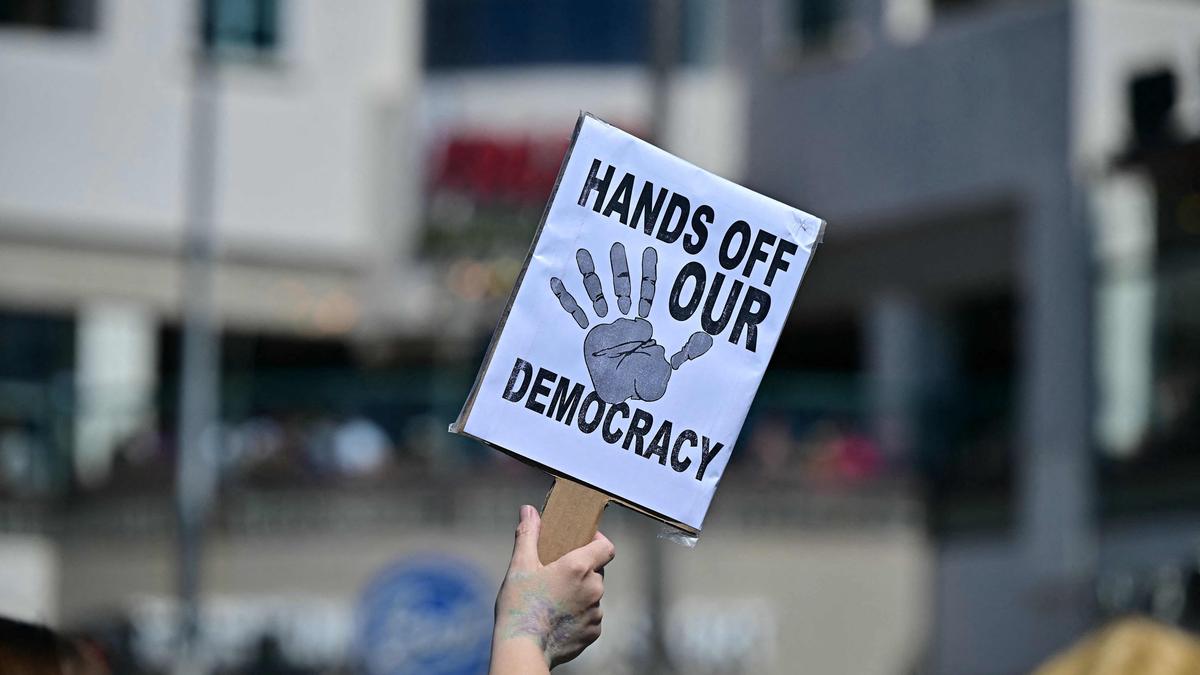A protestor holds a sign during a “Hands Off!” protest against the policies of U.S. President Donald Trump in Huntington Beach, California, on April 5.
| Photo Credit: AFP
The story so far: On March 30, the 78-year-old U.S. President Donald Trump said he’s “not joking” about serving a third term in the White House. He further claimed that a legal loophole could make it possible.
Also Read: ‘Hang tough, it won’t be easy’: Trump defiant on tariffs
Does the U.S. Constitution allow it?
The 22nd Amendment to the U.S. Constitution, ratified on February 27, 1951, limits U.S. Presidents to two elected terms. It was brought in response to Franklin D. Roosevelt’s unprecedented ‘four-term’ Presidency (1933–1945), which broke the ‘two-term’ unwritten precedent set by the nation’s first President, George Washington, who voluntarily declined a third term in 1796.

The Amendment prohibits anyone from being elected President more than twice, and if someone has served as President for more than two years of another’s term (for example, a Vice President who became President due to the President’s death or resignation), they can only be elected once. Thus, effectively, the maximum U.S. Presidential tenure can be 10 years (two years as a successor plus two full terms). For Mr. Trump, elected in 2016 and 2024, the 22nd Amendment unequivocally bars a third term, due to his two elected tenures (2017–2021 and 2025–2029), regardless of their ‘non-consecutive’ nature.
What is the ‘VP loophole’?
Despite the 22nd Amendment’s clarity, Mr. Trump has suggested ways to circumvent it. One idea he proposed involves J.D. Vance running for President in 2028 with Mr. Trump as Vice President (VP). If elected, Mr. Vance would resign, allowing Trump to assume the Presidency. However, the 12th Amendment blocks this strategy, stating: “No person constitutionally ineligible to the office of President shall be eligible to that of Vice-President of the United States.” Since the 22nd Amendment bars Mr. Trump from another term, he cannot serve as VP either.

While the VP route is blocked, another theoretical path exists through ‘succession’, as explained by Professor Bruce G. Peabody in his paper. The 22nd Amendment prohibits a person from being “elected” to the Presidency more than twice but does not bar “serving” beyond two terms. In other words, a twice-elected President could ascend to the Oval Office via the line of succession, such as by becoming Speaker of the House, who is elected by members of the House and need not himself be a member of Congress, if the President and VP become unavailable.
A third pathway — repealing the 22nd Amendment — is highly unlikely. Under Article V, this requires either a two-thirds vote in both the House and the Senate or a ‘constitutional convention’— a process never used — called for by two-thirds (34) of State legislatures, followed by ratification by three-fourths (38) of the 50 States. Given the current U.S. political landscape, the likelihood of Mr. Trump securing a constitutional amendment, which has not been done in the past 33 years, is virtually non-existent.
Which world leaders have extended their tenure?
Leaders all over the world have skilfully extended their rule by reshaping constitutional limits. For instance, Vladimir Putin, after two terms as Russia’s President (2000-2008), hit the ‘consecutive’ two-term limit under Article 81(3) of the 1993 Constitution. To circumvent this limit, he then became Prime Minister (2008–2012) as his ally Dmitry Medvedev took the Presidency and extended the Presidential term from four to six years. Returning as President in 2012 and 2018, Mr. Putin, with a 2020 amendment backed by a loyal Duma and judiciary, reset his term count, potentially holding power until 2036.
Türkiye’s Recep Tayyip Erdogan, Prime Minister (2003-2014), turned President, axed term limits via a 2017 referendum, and reshaped Türkiye’s system into a Presidential one. Similarly, China’s Xi Jinping eliminated the two-term cap in 2018. This change allowed Mr. Xi to rule indefinitely, cementing his hold over the party and the State.
Also Read: Recep Tayyip Erdogan | Turkey’s republican monarch
Yet, some leaders thrive without rewriting the rules. In Germany, where chancellors face no ‘term limits’ but need ‘Parliamentary support’, Angela Merkel ruled for 16 years. Similarly, Prime Ministers in Canada and Britain, unbound by fixed terms, can lead indefinitely, sustained by ‘party confidence’.
Why doesn’t India have term limits?
Unlike the U.S. Presidential framework, India’s Parliamentary system imposes no term limits on its Prime Minister, as tenure depends on retaining the Lok Sabha’s confidence (Article 75(3)). This design ensures ‘voter sovereignty’, ‘democratic flexibility’, and ‘parliamentary accountability’, allowing leaders who sustain public trust to serve extended periods. For instance, current Prime Minister Narendra Modi could serve 15 years by 2029. However, the system also includes checks like the “no-confidence” motion, which has historically ended tenures — such as those of V.P. Singh (1990), H.D. Deve Gowda (1997) and Atal Bihari Vajpayee (1999). Moreover, regular elections, coalition dynamics, floor debates, judicial oversight, and a free press ensure a robust democratic balance.
Kartikey Singh is a final year student at RGNUL, Patiala, Punjab.
Published – April 07, 2025 08:30 am IST

